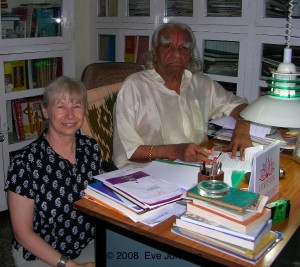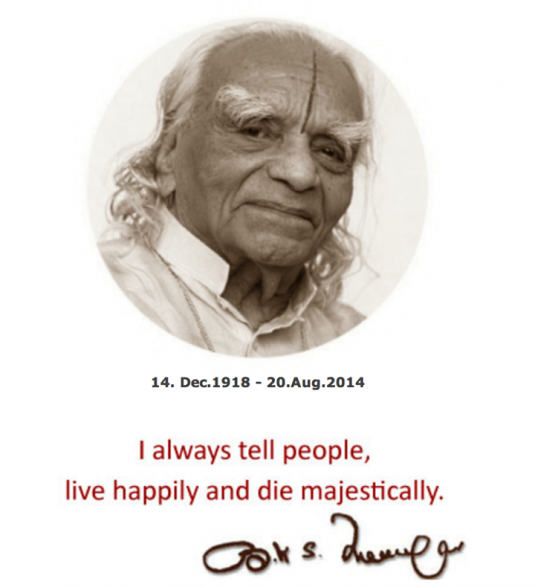One of the better reflections on a life well-lived
by Eve Johnson
In the week and a bit since B.K.S. Iyengar died, this has become my new favorite quote. And as each day passes, I am more grateful to him for setting such a good example of a happy life and a majestic death.
Yes, he could glower. Yes, he yelled in class. But he was not an angry man. He was impish. He took on his role as the traditional tough-love Indian teacher and played it to the hilt, impatient, frustrated by his students’ inability to grasp immediately what he taught.
But anyone who has read Basic Guidelines for Teachers of Yoga, a RIMYI publication from 2002, will see a different attitude:
“After class, your homework is to understand why the student is not getting the asana. You have to reflect on their problems. Think and re-think. And then work on your own. This way you will find that the students improve as the quality of your practice in teaching improves.
“Externally treat your students as students, but internally treat them as God-sent. You are learning by helping them. They make you understand and you must give them respect.”
He lived his own advice, endlessly, inventively finding new ways to transmit understanding. He created a body of work that was never static because he was always teaching new actions, new meditative pathways, new adaptations to take us so deeply into the poses that we would be able to connect to our true selves.
 I have, by the way, my own picture of Guruji glowering, but remember, this is a man interrupted at his work by an unknown student looking for a souvenir photo – and he didn’t say no.
I have, by the way, my own picture of Guruji glowering, but remember, this is a man interrupted at his work by an unknown student looking for a souvenir photo – and he didn’t say no.
The longer he lived, the happier he seemed to be.
And then came the majestic death: clarity until the end, and no sign that he had changed his mind from the days when he’d say, “when death comes I will welcome it.”
Death might be the ultimate opportunity to practice letting go, but Guruji also gave a much longer, more public lesson in perfecting the art of losing.
Watch a video of him demonstrating his practice when he was in his prime, anywhere from 20 to 80, and you will see how able he was, what astonishing poses he could do.
Then gradually he let go, not of the practice, but of the asana work that was no longer possible for him. A 45-minute headstand with full variations became headstand at the wall, then headstand in the ropes, then headstand with the support of the trestler, a wooden horse used in Iyengar work.
Fully supported, he still did astonishing backbends. And he was present in each pose completely, no wavering of attention, no loss of awareness. His practice remained meditation in action, performed with the joy and gratitude of one who famously said: “The body is my temple, asanas are my prayers.”
As he aged, he let go of what he could no longer do, but always did as much as he could. He never gave up, never said, “I’m too old to practice.” In his last years, he used an elevator to get to the practice room because he couldn’t manage the stairs, but he was there every day. He always practiced with his students. He never hid his losses. He continued, day by day, to do as much as he could, with humility and gratitude.
I think about my own struggle with full arm balance, a pose I find both difficult and magical. I worked for so long to be able to kick up, and had a few glorious years of a reliable pose. Now it’s gone again. I had a niggling elbow injury that made weight-bearing on a straight arm undesirable, so I stopped trying to kick up, and now I can’t.
Could it be that it’s time for me to quit trying? To accept that I’ll only do the full pose with a helper? Logically, there will be a last time for every pose. I have plenty of preparations I can work with, ways to practice that will keep me strong without needing to kick up.
Could I let go of that pose with such grace? Start teaching arm balance without being able to demonstrate it? Could I be honest in saying: “this is not a pose I do any more”?
If B.K.S. Iyengar didn’t magically escape death through the practice of yoga, then I won’t either. If age diminished his extraordinary asana practice, then it will surely diminish mine.
I will always be grateful for having found Guruji’s work, this method of rigorous questioning, of growing inwardly through exploring the asanas.
I suspect that as years go by I may be even more grateful for his lesson in how to consciously surrender to the reality of an aging body, while living happily, and aiming for a majestic death.
About Me
source http://myfiveminuteyoga.com/5289/lessons-in-letting-go-from-b-k-s-iyengar/


 My name is Eve Johnson.
My name is Eve Johnson.